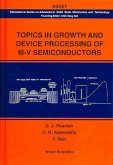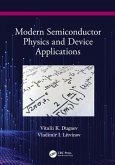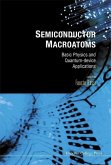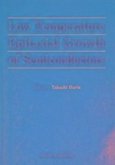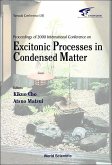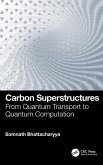Kazuya Masu, Shuhei Amakawa
Elementary Semiconductor Device Physics
Understanding Energy Band Formation Using Circuit Theory
Kazuya Masu, Shuhei Amakawa
Elementary Semiconductor Device Physics
Understanding Energy Band Formation Using Circuit Theory
- Gebundenes Buch
- Merkliste
- Auf die Merkliste
- Bewerten Bewerten
- Teilen
- Produkt teilen
- Produkterinnerung
- Produkterinnerung
This book by two leading experts on integrated circuit design adopts an untraditional approach to introducing semiconductor devices to beginners. The authors use circuit theory to provide a digestible explanation of energy band theory and understanding of energy band diagrams.
Andere Kunden interessierten sich auch für
![Topics in Growth and Device Processing of III-V Semiconductors Topics in Growth and Device Processing of III-V Semiconductors]() Cammy R AbernathyTopics in Growth and Device Processing of III-V Semiconductors132,99 €
Cammy R AbernathyTopics in Growth and Device Processing of III-V Semiconductors132,99 €![Making a Semiconductor Superpower Making a Semiconductor Superpower]() Dong-Won KimMaking a Semiconductor Superpower163,99 €
Dong-Won KimMaking a Semiconductor Superpower163,99 €![Modern Semiconductor Physics and Device Applications Modern Semiconductor Physics and Device Applications]() Vitalii DugaevModern Semiconductor Physics and Device Applications174,99 €
Vitalii DugaevModern Semiconductor Physics and Device Applications174,99 €![Semiconductor Macroatoms: Basics Physics and Quantum-Device Applications Semiconductor Macroatoms: Basics Physics and Quantum-Device Applications]() Fausto RossiSemiconductor Macroatoms: Basics Physics and Quantum-Device Applications125,99 €
Fausto RossiSemiconductor Macroatoms: Basics Physics and Quantum-Device Applications125,99 €![Low Temperature Epitaxial Growth of Semiconductors Low Temperature Epitaxial Growth of Semiconductors]() Low Temperature Epitaxial Growth of Semiconductors233,99 €
Low Temperature Epitaxial Growth of Semiconductors233,99 €![Excitonic Processes in Condensed Matter, Proceedings of 2000 International Conference (Excon2000) Excitonic Processes in Condensed Matter, Proceedings of 2000 International Conference (Excon2000)]() Excitonic Processes in Condensed Matter, Proceedings of 2000 International Conference (Excon2000)320,99 €
Excitonic Processes in Condensed Matter, Proceedings of 2000 International Conference (Excon2000)320,99 €![Carbon Superstructures Carbon Superstructures]() Somnath BhattacharyyaCarbon Superstructures154,99 €
Somnath BhattacharyyaCarbon Superstructures154,99 €-
-
-
This book by two leading experts on integrated circuit design adopts an untraditional approach to introducing semiconductor devices to beginners. The authors use circuit theory to provide a digestible explanation of energy band theory and understanding of energy band diagrams.
Hinweis: Dieser Artikel kann nur an eine deutsche Lieferadresse ausgeliefert werden.
Hinweis: Dieser Artikel kann nur an eine deutsche Lieferadresse ausgeliefert werden.
Produktdetails
- Produktdetails
- Verlag: CRC Press
- Seitenzahl: 330
- Erscheinungstermin: 31. Oktober 2024
- Englisch
- Abmessung: 234mm x 156mm x 21mm
- Gewicht: 680g
- ISBN-13: 9781032574479
- ISBN-10: 103257447X
- Artikelnr.: 70772341
- Herstellerkennzeichnung
- Libri GmbH
- Europaallee 1
- 36244 Bad Hersfeld
- gpsr@libri.de
- Verlag: CRC Press
- Seitenzahl: 330
- Erscheinungstermin: 31. Oktober 2024
- Englisch
- Abmessung: 234mm x 156mm x 21mm
- Gewicht: 680g
- ISBN-13: 9781032574479
- ISBN-10: 103257447X
- Artikelnr.: 70772341
- Herstellerkennzeichnung
- Libri GmbH
- Europaallee 1
- 36244 Bad Hersfeld
- gpsr@libri.de
Kazuya Masu is President of Tokyo Institute of Technology (Tokyo Tech), a position he has held since 2018. He earned his bachelor's, master's, and doctoral degrees in engineering from Tokyo Tech in 1977, 1979, and 1982 respectively. He is a member of IEEE. Shuhei Amakawa is Professor at Hiroshima University. He received his B.Eng., M.Eng., and Ph.D. degrees in engineering from the University of Tokyo, Tokyo in 1995, 1997, and 2001, respectively, and his M.Phil. degree in physics from the University of Cambridge in 2000. He served/serves as a Committee Member for the International Solid-State Circuits Conference and the International Microwave Symposium and is a member of IEEE.
Preface xiv Symbol Index xix Chapter 1
Introduction 1 1.1 WHAT ARE SEMICONDUCTOR DEVICES? 1 1.2 CLASSIFICATION OF SOLIDS 1 1.3 PROPERTIES OF SEMICONDUCTORS 6 1.3.1 Arrangement of Atoms 6 1.3.2 Intrinsic and Doped Semiconductors 7 1.3.3 Carriers in Intrinsic Semiconductors 7 1.3.4 Energy Band Formation 8 1.3.5 Properties of Intrinsic Semiconductors 11 1.3.6 Energy Band Diagrams 13 1.3.7 n-Type and p-Type Semiconductors 16 1.4 WHAT IS THE MOST ABUNDANT ARTIFACT ON EARTH? 23 1.5 SUMMARY 25 1.6 PROBLEMS 26 Chapter 2
Semiconductor Devices from a Circuit-Theoretic Standpoint 28 2.1 LINEAR CIRCUIT ELEMENTS 28 2.1.1 Linear Resistors 29 2.1.2 Linear Capacitors 29 2.1.3 Linear Inductors 32 2.2 NONLINEAR CIRCUIT ELEMENTS 32 2.2.1 Nonlinear Resistors 33 2.2.2 Nonlinear Capacitors and Inductors 36 2.3 TIME-INVARIANT AND TIME-VARYING CIRCUIT ELEMENTS 40 2.4 MULTITERMINAL ELEMENTS AND CONTROLLED SOURCES 41 2.5 TRANSISTORS 43 2.6 CIRCUIT-THEORETIC POSITIONING OF SEMICONDUCTOR DEVICES 46 2.7 SUMMARY 47 2.8 PROBLEMS 49 Chapter 3
Waves in Periodic Structures 50 3.1 ANALOGIES IN PHYSICS 50 3.1.1 Commonality of Mathematical Structures 50 3.1.2 Overview of the Chapter 52 3.2 PROPERTIES OF PERIODIC NETWORKS 55 3.2.1 Infinitely Long Ladder Networks 55 3.2.2 Infinitely Long LC Ladders 57 3.2.3 Lossless Transmission Lines 60 3.2.4 Periodic Networks with a Finite Number of Repetitions 66 3.2.5 Kronig-Penney Model 69 3.3 DISPERSION RELATION AND PHASE AND GROUP VELOCITIES 71 3.3.1 Dispersion Relation 71 3.3.2 Phase Velocity and Group Velocity 74 3.3.3 Calculation of the Dispersion Relation 76 3.4 DISPERSION RELATION AND PROPERTIES OF SEMICONDUCTORS 79 3.5 BRAGG REFLECTION 83 3.6 SUMMARY 85 3.7 PROBLEMS 85 Chapter 4
Physics of Semiconductors in Equilibrium 87 4.1 DENSITY OF STATES IN ENERGY BAND AND DISTRIBUTION FUNCTION 87 4.2 CARRIER DENSITIES OF NONDEGENERATE SEMICONDUCTORS 91 4.2.1 Electron Density 91 4.2.2 Hole Density 93 4.2.3 Product of Hole and Electron Densities 94 4.2.4 Insulators 95 4.2.5 Fermi Level of Intrinsic Semiconductors 96 4.2.6 Carrier Density in Terms of Intrinsic Carrier Density 97 4.3 FERMI LEVEL OF DOPED SEMICONDUCTORS 98 4.3.1 Nondegenerately Doped Semiconductors 98 4.3.2 Degenerate Semiconductors 104 4.4 FERMI LEVEL AND CHEMICAL POTENTIAL 106 4.4.1 Properties of Chemical Potential 106 4.4.2 Chemical Potential in the Presence of an External Force 109 4.5 SUMMARY 112 4.6 PROBLEMS 112 Chapter 5
Carrier Dynamics in Semiconductors 115 5.1 EQUILIBRIUM AND NONEQUILIBRIUM STATES, STEADY AND NONSTEADY STATES 115 5.2 QUASI-FERMI LEVELS AND CARRIER DENSITIES 117 5.2.1 Quasi-Chemical Potential 117 5.2.2 Electron and Hole Quasi-Fermi Levels 119 5.2.3 Nonequilibrium Carrier Densities 123 5.2.4 Logarithmic Transform of Carrier Densities 125 5.2.5 General Form of Nondegenerate Carrier Density Expressions 128 5.3 QUASI-FERMI LEVELS AND CURRENT DENSITY 129 5.3.1 Carrier Flux Density and Current Density 129 5.3.2 Quasi-Fermi Level Gradient and Current Density 131 5.3.3 Drift and Diffusion of Carriers 132 5.4 ELECTRIC CONDUCTION DUE TO ELECTRIC FIELD 133 5.4.1 Drift of Carriers 133 5.4.2 Relationship between Mobility and Conductivity 138 5.5 ELECTRIC CONDUCTION DUE TO CARRIER DIFFUSION 139 5.5.1 Diffusion Current 140 5.5.2 Einstein's Relation 141 5.6 CARRIER GENERATION AND RECOMBINATION 143 5.6.1 Direct Generation and Recombination 143 5.6.2 Indirect Generation and Recombination 144 5.6.3 Carrier Generation-Recombination Rates 148 5.6.4 Minority Carrier Lifetime 149 5.7 BASIC EQUATIONS FOR SEMICONDUCTOR DEVICES 151 5.8 DIELECTRIC RELAXATION 155 5.9 DEBYE LENGTH 157 Chapter 6
p-n Junctions 167 6.1 WHAT IS A P-N JUNCTION? 167 6.2 CONTACT POTENTIAL 168 6.2.1 What Is Contact Potential? 168 6.2.2 Work Function and Electron Affinity 170 6.2.3 Properties of Contact Potential 173 6.3 FORMATION OF A P-N JUNCTION 174 6.3.1 Contact between p-Type and n-Type Semiconductors 174 6.3.2 p-n Junctions in Equilibrium 175 6.3.3 Biased p-n Junctions 177 6.4 QUALITATIVE DESCRIPTION OF RECTIFICATION 178 6.5 ANALYSIS OF ABRUPT JUNCTIONS 181 6.5.1 Zero-Bias Abrupt Junctions 181 6.5.2 Biased Abrupt Junctions 186 6.6 CAPACITANCE OF P-N JUNCTIONS 188 6.6.1 Depletion Capacitance 188 6.6.2 Diffusion Capacitance 189 6.7 ONE-SIDED ABRUPT JUNCTIONS 189 6.8 CURRENT-VOLTAGE CHARACTERISTICS OF P-N JUNCTIONS 190 6.8.1 Equation of Current-Voltage Characteristics 190 6.8.2 Derivation of Current-Voltage Characteristics 191 6.8.3 Additional Notes on p-n Junctions 199 6.9 READING ENERGY BAND DIAGRAMS OF P-N JUNCTIONS 203 6.9.1 Bias Voltage Dependence 203 6.9.2 Lifetime Dependence 208 Chapter 7
MOS Transistors 215 7.1 MOSFET STRUCTURE AND BASIC CHARACTERISTICS 215 7.1.1 Structure of MOSFETs 215 7.1.2 Basic Characteristics of MOSFETs 218 7.1.3 Outline of Analyzing MOSFETs 221 7.2 MOS CAPACITOR 221 7.2.1 Structure of MOS Capacitors 221 7.2.2 Analysis of MOS Capacitors 222 7.2.3 Classification of Surface Conditions of MOS Capacitors 225 7.2.4 Surface Electron Density and Surface Potential 232 7.2.5 Relation between Gate Voltage and Inversion Charge 234 7.2.6 Relation between Gate Voltage and Surface Potential 236 7.3 THREE-TERMINAL MOS STRUCTURES 240 7.3.1 Back-Gate-Referenced Analysis 241 7.3.2 Channel-Terminal-Referenced Analysis 246 7.4 FOUR-TERMINAL MOSFET 248 7.4.1 Back-Gate-Referenced Analysis 248 7.4.2 Source-Referenced Analysis 256 7.5 SCALING AND SHORT-CHANNEL MOSFETS 257 7.5.1 MOSFET Scaling 257 7.5.2 Short-Channel Effects 260 7.6 SUMMARY 263 7.7 PROBLEMS 264 Chapter 8
Appendix 269 A.1 MATRIX REPRESENTATIONS OF A TWO-PORT 269 A.1.1 ABCD-Matrix 269 A.1.2 S-Matrix 270 A.2 NTH POWER OF UNIMODULAR MATRIX 272 Chapter 9
Solutions to Selected Problems 275 A.3.1 CHAPTER 1 275 A.3.2 CHAPTER 2 278 A.3.3 CHAPTER 3 279 A.3.4 CHAPTER 4 281 A.3.5 CHAPTER 5 286 A.3.6 CHAPTER 6 289 A.3.7 CHAPTER 7 292 References 299 Index 303
Introduction 1 1.1 WHAT ARE SEMICONDUCTOR DEVICES? 1 1.2 CLASSIFICATION OF SOLIDS 1 1.3 PROPERTIES OF SEMICONDUCTORS 6 1.3.1 Arrangement of Atoms 6 1.3.2 Intrinsic and Doped Semiconductors 7 1.3.3 Carriers in Intrinsic Semiconductors 7 1.3.4 Energy Band Formation 8 1.3.5 Properties of Intrinsic Semiconductors 11 1.3.6 Energy Band Diagrams 13 1.3.7 n-Type and p-Type Semiconductors 16 1.4 WHAT IS THE MOST ABUNDANT ARTIFACT ON EARTH? 23 1.5 SUMMARY 25 1.6 PROBLEMS 26 Chapter 2
Semiconductor Devices from a Circuit-Theoretic Standpoint 28 2.1 LINEAR CIRCUIT ELEMENTS 28 2.1.1 Linear Resistors 29 2.1.2 Linear Capacitors 29 2.1.3 Linear Inductors 32 2.2 NONLINEAR CIRCUIT ELEMENTS 32 2.2.1 Nonlinear Resistors 33 2.2.2 Nonlinear Capacitors and Inductors 36 2.3 TIME-INVARIANT AND TIME-VARYING CIRCUIT ELEMENTS 40 2.4 MULTITERMINAL ELEMENTS AND CONTROLLED SOURCES 41 2.5 TRANSISTORS 43 2.6 CIRCUIT-THEORETIC POSITIONING OF SEMICONDUCTOR DEVICES 46 2.7 SUMMARY 47 2.8 PROBLEMS 49 Chapter 3
Waves in Periodic Structures 50 3.1 ANALOGIES IN PHYSICS 50 3.1.1 Commonality of Mathematical Structures 50 3.1.2 Overview of the Chapter 52 3.2 PROPERTIES OF PERIODIC NETWORKS 55 3.2.1 Infinitely Long Ladder Networks 55 3.2.2 Infinitely Long LC Ladders 57 3.2.3 Lossless Transmission Lines 60 3.2.4 Periodic Networks with a Finite Number of Repetitions 66 3.2.5 Kronig-Penney Model 69 3.3 DISPERSION RELATION AND PHASE AND GROUP VELOCITIES 71 3.3.1 Dispersion Relation 71 3.3.2 Phase Velocity and Group Velocity 74 3.3.3 Calculation of the Dispersion Relation 76 3.4 DISPERSION RELATION AND PROPERTIES OF SEMICONDUCTORS 79 3.5 BRAGG REFLECTION 83 3.6 SUMMARY 85 3.7 PROBLEMS 85 Chapter 4
Physics of Semiconductors in Equilibrium 87 4.1 DENSITY OF STATES IN ENERGY BAND AND DISTRIBUTION FUNCTION 87 4.2 CARRIER DENSITIES OF NONDEGENERATE SEMICONDUCTORS 91 4.2.1 Electron Density 91 4.2.2 Hole Density 93 4.2.3 Product of Hole and Electron Densities 94 4.2.4 Insulators 95 4.2.5 Fermi Level of Intrinsic Semiconductors 96 4.2.6 Carrier Density in Terms of Intrinsic Carrier Density 97 4.3 FERMI LEVEL OF DOPED SEMICONDUCTORS 98 4.3.1 Nondegenerately Doped Semiconductors 98 4.3.2 Degenerate Semiconductors 104 4.4 FERMI LEVEL AND CHEMICAL POTENTIAL 106 4.4.1 Properties of Chemical Potential 106 4.4.2 Chemical Potential in the Presence of an External Force 109 4.5 SUMMARY 112 4.6 PROBLEMS 112 Chapter 5
Carrier Dynamics in Semiconductors 115 5.1 EQUILIBRIUM AND NONEQUILIBRIUM STATES, STEADY AND NONSTEADY STATES 115 5.2 QUASI-FERMI LEVELS AND CARRIER DENSITIES 117 5.2.1 Quasi-Chemical Potential 117 5.2.2 Electron and Hole Quasi-Fermi Levels 119 5.2.3 Nonequilibrium Carrier Densities 123 5.2.4 Logarithmic Transform of Carrier Densities 125 5.2.5 General Form of Nondegenerate Carrier Density Expressions 128 5.3 QUASI-FERMI LEVELS AND CURRENT DENSITY 129 5.3.1 Carrier Flux Density and Current Density 129 5.3.2 Quasi-Fermi Level Gradient and Current Density 131 5.3.3 Drift and Diffusion of Carriers 132 5.4 ELECTRIC CONDUCTION DUE TO ELECTRIC FIELD 133 5.4.1 Drift of Carriers 133 5.4.2 Relationship between Mobility and Conductivity 138 5.5 ELECTRIC CONDUCTION DUE TO CARRIER DIFFUSION 139 5.5.1 Diffusion Current 140 5.5.2 Einstein's Relation 141 5.6 CARRIER GENERATION AND RECOMBINATION 143 5.6.1 Direct Generation and Recombination 143 5.6.2 Indirect Generation and Recombination 144 5.6.3 Carrier Generation-Recombination Rates 148 5.6.4 Minority Carrier Lifetime 149 5.7 BASIC EQUATIONS FOR SEMICONDUCTOR DEVICES 151 5.8 DIELECTRIC RELAXATION 155 5.9 DEBYE LENGTH 157 Chapter 6
p-n Junctions 167 6.1 WHAT IS A P-N JUNCTION? 167 6.2 CONTACT POTENTIAL 168 6.2.1 What Is Contact Potential? 168 6.2.2 Work Function and Electron Affinity 170 6.2.3 Properties of Contact Potential 173 6.3 FORMATION OF A P-N JUNCTION 174 6.3.1 Contact between p-Type and n-Type Semiconductors 174 6.3.2 p-n Junctions in Equilibrium 175 6.3.3 Biased p-n Junctions 177 6.4 QUALITATIVE DESCRIPTION OF RECTIFICATION 178 6.5 ANALYSIS OF ABRUPT JUNCTIONS 181 6.5.1 Zero-Bias Abrupt Junctions 181 6.5.2 Biased Abrupt Junctions 186 6.6 CAPACITANCE OF P-N JUNCTIONS 188 6.6.1 Depletion Capacitance 188 6.6.2 Diffusion Capacitance 189 6.7 ONE-SIDED ABRUPT JUNCTIONS 189 6.8 CURRENT-VOLTAGE CHARACTERISTICS OF P-N JUNCTIONS 190 6.8.1 Equation of Current-Voltage Characteristics 190 6.8.2 Derivation of Current-Voltage Characteristics 191 6.8.3 Additional Notes on p-n Junctions 199 6.9 READING ENERGY BAND DIAGRAMS OF P-N JUNCTIONS 203 6.9.1 Bias Voltage Dependence 203 6.9.2 Lifetime Dependence 208 Chapter 7
MOS Transistors 215 7.1 MOSFET STRUCTURE AND BASIC CHARACTERISTICS 215 7.1.1 Structure of MOSFETs 215 7.1.2 Basic Characteristics of MOSFETs 218 7.1.3 Outline of Analyzing MOSFETs 221 7.2 MOS CAPACITOR 221 7.2.1 Structure of MOS Capacitors 221 7.2.2 Analysis of MOS Capacitors 222 7.2.3 Classification of Surface Conditions of MOS Capacitors 225 7.2.4 Surface Electron Density and Surface Potential 232 7.2.5 Relation between Gate Voltage and Inversion Charge 234 7.2.6 Relation between Gate Voltage and Surface Potential 236 7.3 THREE-TERMINAL MOS STRUCTURES 240 7.3.1 Back-Gate-Referenced Analysis 241 7.3.2 Channel-Terminal-Referenced Analysis 246 7.4 FOUR-TERMINAL MOSFET 248 7.4.1 Back-Gate-Referenced Analysis 248 7.4.2 Source-Referenced Analysis 256 7.5 SCALING AND SHORT-CHANNEL MOSFETS 257 7.5.1 MOSFET Scaling 257 7.5.2 Short-Channel Effects 260 7.6 SUMMARY 263 7.7 PROBLEMS 264 Chapter 8
Appendix 269 A.1 MATRIX REPRESENTATIONS OF A TWO-PORT 269 A.1.1 ABCD-Matrix 269 A.1.2 S-Matrix 270 A.2 NTH POWER OF UNIMODULAR MATRIX 272 Chapter 9
Solutions to Selected Problems 275 A.3.1 CHAPTER 1 275 A.3.2 CHAPTER 2 278 A.3.3 CHAPTER 3 279 A.3.4 CHAPTER 4 281 A.3.5 CHAPTER 5 286 A.3.6 CHAPTER 6 289 A.3.7 CHAPTER 7 292 References 299 Index 303
Preface xiv Symbol Index xix Chapter 1
Introduction 1 1.1 WHAT ARE SEMICONDUCTOR DEVICES? 1 1.2 CLASSIFICATION OF SOLIDS 1 1.3 PROPERTIES OF SEMICONDUCTORS 6 1.3.1 Arrangement of Atoms 6 1.3.2 Intrinsic and Doped Semiconductors 7 1.3.3 Carriers in Intrinsic Semiconductors 7 1.3.4 Energy Band Formation 8 1.3.5 Properties of Intrinsic Semiconductors 11 1.3.6 Energy Band Diagrams 13 1.3.7 n-Type and p-Type Semiconductors 16 1.4 WHAT IS THE MOST ABUNDANT ARTIFACT ON EARTH? 23 1.5 SUMMARY 25 1.6 PROBLEMS 26 Chapter 2
Semiconductor Devices from a Circuit-Theoretic Standpoint 28 2.1 LINEAR CIRCUIT ELEMENTS 28 2.1.1 Linear Resistors 29 2.1.2 Linear Capacitors 29 2.1.3 Linear Inductors 32 2.2 NONLINEAR CIRCUIT ELEMENTS 32 2.2.1 Nonlinear Resistors 33 2.2.2 Nonlinear Capacitors and Inductors 36 2.3 TIME-INVARIANT AND TIME-VARYING CIRCUIT ELEMENTS 40 2.4 MULTITERMINAL ELEMENTS AND CONTROLLED SOURCES 41 2.5 TRANSISTORS 43 2.6 CIRCUIT-THEORETIC POSITIONING OF SEMICONDUCTOR DEVICES 46 2.7 SUMMARY 47 2.8 PROBLEMS 49 Chapter 3
Waves in Periodic Structures 50 3.1 ANALOGIES IN PHYSICS 50 3.1.1 Commonality of Mathematical Structures 50 3.1.2 Overview of the Chapter 52 3.2 PROPERTIES OF PERIODIC NETWORKS 55 3.2.1 Infinitely Long Ladder Networks 55 3.2.2 Infinitely Long LC Ladders 57 3.2.3 Lossless Transmission Lines 60 3.2.4 Periodic Networks with a Finite Number of Repetitions 66 3.2.5 Kronig-Penney Model 69 3.3 DISPERSION RELATION AND PHASE AND GROUP VELOCITIES 71 3.3.1 Dispersion Relation 71 3.3.2 Phase Velocity and Group Velocity 74 3.3.3 Calculation of the Dispersion Relation 76 3.4 DISPERSION RELATION AND PROPERTIES OF SEMICONDUCTORS 79 3.5 BRAGG REFLECTION 83 3.6 SUMMARY 85 3.7 PROBLEMS 85 Chapter 4
Physics of Semiconductors in Equilibrium 87 4.1 DENSITY OF STATES IN ENERGY BAND AND DISTRIBUTION FUNCTION 87 4.2 CARRIER DENSITIES OF NONDEGENERATE SEMICONDUCTORS 91 4.2.1 Electron Density 91 4.2.2 Hole Density 93 4.2.3 Product of Hole and Electron Densities 94 4.2.4 Insulators 95 4.2.5 Fermi Level of Intrinsic Semiconductors 96 4.2.6 Carrier Density in Terms of Intrinsic Carrier Density 97 4.3 FERMI LEVEL OF DOPED SEMICONDUCTORS 98 4.3.1 Nondegenerately Doped Semiconductors 98 4.3.2 Degenerate Semiconductors 104 4.4 FERMI LEVEL AND CHEMICAL POTENTIAL 106 4.4.1 Properties of Chemical Potential 106 4.4.2 Chemical Potential in the Presence of an External Force 109 4.5 SUMMARY 112 4.6 PROBLEMS 112 Chapter 5
Carrier Dynamics in Semiconductors 115 5.1 EQUILIBRIUM AND NONEQUILIBRIUM STATES, STEADY AND NONSTEADY STATES 115 5.2 QUASI-FERMI LEVELS AND CARRIER DENSITIES 117 5.2.1 Quasi-Chemical Potential 117 5.2.2 Electron and Hole Quasi-Fermi Levels 119 5.2.3 Nonequilibrium Carrier Densities 123 5.2.4 Logarithmic Transform of Carrier Densities 125 5.2.5 General Form of Nondegenerate Carrier Density Expressions 128 5.3 QUASI-FERMI LEVELS AND CURRENT DENSITY 129 5.3.1 Carrier Flux Density and Current Density 129 5.3.2 Quasi-Fermi Level Gradient and Current Density 131 5.3.3 Drift and Diffusion of Carriers 132 5.4 ELECTRIC CONDUCTION DUE TO ELECTRIC FIELD 133 5.4.1 Drift of Carriers 133 5.4.2 Relationship between Mobility and Conductivity 138 5.5 ELECTRIC CONDUCTION DUE TO CARRIER DIFFUSION 139 5.5.1 Diffusion Current 140 5.5.2 Einstein's Relation 141 5.6 CARRIER GENERATION AND RECOMBINATION 143 5.6.1 Direct Generation and Recombination 143 5.6.2 Indirect Generation and Recombination 144 5.6.3 Carrier Generation-Recombination Rates 148 5.6.4 Minority Carrier Lifetime 149 5.7 BASIC EQUATIONS FOR SEMICONDUCTOR DEVICES 151 5.8 DIELECTRIC RELAXATION 155 5.9 DEBYE LENGTH 157 Chapter 6
p-n Junctions 167 6.1 WHAT IS A P-N JUNCTION? 167 6.2 CONTACT POTENTIAL 168 6.2.1 What Is Contact Potential? 168 6.2.2 Work Function and Electron Affinity 170 6.2.3 Properties of Contact Potential 173 6.3 FORMATION OF A P-N JUNCTION 174 6.3.1 Contact between p-Type and n-Type Semiconductors 174 6.3.2 p-n Junctions in Equilibrium 175 6.3.3 Biased p-n Junctions 177 6.4 QUALITATIVE DESCRIPTION OF RECTIFICATION 178 6.5 ANALYSIS OF ABRUPT JUNCTIONS 181 6.5.1 Zero-Bias Abrupt Junctions 181 6.5.2 Biased Abrupt Junctions 186 6.6 CAPACITANCE OF P-N JUNCTIONS 188 6.6.1 Depletion Capacitance 188 6.6.2 Diffusion Capacitance 189 6.7 ONE-SIDED ABRUPT JUNCTIONS 189 6.8 CURRENT-VOLTAGE CHARACTERISTICS OF P-N JUNCTIONS 190 6.8.1 Equation of Current-Voltage Characteristics 190 6.8.2 Derivation of Current-Voltage Characteristics 191 6.8.3 Additional Notes on p-n Junctions 199 6.9 READING ENERGY BAND DIAGRAMS OF P-N JUNCTIONS 203 6.9.1 Bias Voltage Dependence 203 6.9.2 Lifetime Dependence 208 Chapter 7
MOS Transistors 215 7.1 MOSFET STRUCTURE AND BASIC CHARACTERISTICS 215 7.1.1 Structure of MOSFETs 215 7.1.2 Basic Characteristics of MOSFETs 218 7.1.3 Outline of Analyzing MOSFETs 221 7.2 MOS CAPACITOR 221 7.2.1 Structure of MOS Capacitors 221 7.2.2 Analysis of MOS Capacitors 222 7.2.3 Classification of Surface Conditions of MOS Capacitors 225 7.2.4 Surface Electron Density and Surface Potential 232 7.2.5 Relation between Gate Voltage and Inversion Charge 234 7.2.6 Relation between Gate Voltage and Surface Potential 236 7.3 THREE-TERMINAL MOS STRUCTURES 240 7.3.1 Back-Gate-Referenced Analysis 241 7.3.2 Channel-Terminal-Referenced Analysis 246 7.4 FOUR-TERMINAL MOSFET 248 7.4.1 Back-Gate-Referenced Analysis 248 7.4.2 Source-Referenced Analysis 256 7.5 SCALING AND SHORT-CHANNEL MOSFETS 257 7.5.1 MOSFET Scaling 257 7.5.2 Short-Channel Effects 260 7.6 SUMMARY 263 7.7 PROBLEMS 264 Chapter 8
Appendix 269 A.1 MATRIX REPRESENTATIONS OF A TWO-PORT 269 A.1.1 ABCD-Matrix 269 A.1.2 S-Matrix 270 A.2 NTH POWER OF UNIMODULAR MATRIX 272 Chapter 9
Solutions to Selected Problems 275 A.3.1 CHAPTER 1 275 A.3.2 CHAPTER 2 278 A.3.3 CHAPTER 3 279 A.3.4 CHAPTER 4 281 A.3.5 CHAPTER 5 286 A.3.6 CHAPTER 6 289 A.3.7 CHAPTER 7 292 References 299 Index 303
Introduction 1 1.1 WHAT ARE SEMICONDUCTOR DEVICES? 1 1.2 CLASSIFICATION OF SOLIDS 1 1.3 PROPERTIES OF SEMICONDUCTORS 6 1.3.1 Arrangement of Atoms 6 1.3.2 Intrinsic and Doped Semiconductors 7 1.3.3 Carriers in Intrinsic Semiconductors 7 1.3.4 Energy Band Formation 8 1.3.5 Properties of Intrinsic Semiconductors 11 1.3.6 Energy Band Diagrams 13 1.3.7 n-Type and p-Type Semiconductors 16 1.4 WHAT IS THE MOST ABUNDANT ARTIFACT ON EARTH? 23 1.5 SUMMARY 25 1.6 PROBLEMS 26 Chapter 2
Semiconductor Devices from a Circuit-Theoretic Standpoint 28 2.1 LINEAR CIRCUIT ELEMENTS 28 2.1.1 Linear Resistors 29 2.1.2 Linear Capacitors 29 2.1.3 Linear Inductors 32 2.2 NONLINEAR CIRCUIT ELEMENTS 32 2.2.1 Nonlinear Resistors 33 2.2.2 Nonlinear Capacitors and Inductors 36 2.3 TIME-INVARIANT AND TIME-VARYING CIRCUIT ELEMENTS 40 2.4 MULTITERMINAL ELEMENTS AND CONTROLLED SOURCES 41 2.5 TRANSISTORS 43 2.6 CIRCUIT-THEORETIC POSITIONING OF SEMICONDUCTOR DEVICES 46 2.7 SUMMARY 47 2.8 PROBLEMS 49 Chapter 3
Waves in Periodic Structures 50 3.1 ANALOGIES IN PHYSICS 50 3.1.1 Commonality of Mathematical Structures 50 3.1.2 Overview of the Chapter 52 3.2 PROPERTIES OF PERIODIC NETWORKS 55 3.2.1 Infinitely Long Ladder Networks 55 3.2.2 Infinitely Long LC Ladders 57 3.2.3 Lossless Transmission Lines 60 3.2.4 Periodic Networks with a Finite Number of Repetitions 66 3.2.5 Kronig-Penney Model 69 3.3 DISPERSION RELATION AND PHASE AND GROUP VELOCITIES 71 3.3.1 Dispersion Relation 71 3.3.2 Phase Velocity and Group Velocity 74 3.3.3 Calculation of the Dispersion Relation 76 3.4 DISPERSION RELATION AND PROPERTIES OF SEMICONDUCTORS 79 3.5 BRAGG REFLECTION 83 3.6 SUMMARY 85 3.7 PROBLEMS 85 Chapter 4
Physics of Semiconductors in Equilibrium 87 4.1 DENSITY OF STATES IN ENERGY BAND AND DISTRIBUTION FUNCTION 87 4.2 CARRIER DENSITIES OF NONDEGENERATE SEMICONDUCTORS 91 4.2.1 Electron Density 91 4.2.2 Hole Density 93 4.2.3 Product of Hole and Electron Densities 94 4.2.4 Insulators 95 4.2.5 Fermi Level of Intrinsic Semiconductors 96 4.2.6 Carrier Density in Terms of Intrinsic Carrier Density 97 4.3 FERMI LEVEL OF DOPED SEMICONDUCTORS 98 4.3.1 Nondegenerately Doped Semiconductors 98 4.3.2 Degenerate Semiconductors 104 4.4 FERMI LEVEL AND CHEMICAL POTENTIAL 106 4.4.1 Properties of Chemical Potential 106 4.4.2 Chemical Potential in the Presence of an External Force 109 4.5 SUMMARY 112 4.6 PROBLEMS 112 Chapter 5
Carrier Dynamics in Semiconductors 115 5.1 EQUILIBRIUM AND NONEQUILIBRIUM STATES, STEADY AND NONSTEADY STATES 115 5.2 QUASI-FERMI LEVELS AND CARRIER DENSITIES 117 5.2.1 Quasi-Chemical Potential 117 5.2.2 Electron and Hole Quasi-Fermi Levels 119 5.2.3 Nonequilibrium Carrier Densities 123 5.2.4 Logarithmic Transform of Carrier Densities 125 5.2.5 General Form of Nondegenerate Carrier Density Expressions 128 5.3 QUASI-FERMI LEVELS AND CURRENT DENSITY 129 5.3.1 Carrier Flux Density and Current Density 129 5.3.2 Quasi-Fermi Level Gradient and Current Density 131 5.3.3 Drift and Diffusion of Carriers 132 5.4 ELECTRIC CONDUCTION DUE TO ELECTRIC FIELD 133 5.4.1 Drift of Carriers 133 5.4.2 Relationship between Mobility and Conductivity 138 5.5 ELECTRIC CONDUCTION DUE TO CARRIER DIFFUSION 139 5.5.1 Diffusion Current 140 5.5.2 Einstein's Relation 141 5.6 CARRIER GENERATION AND RECOMBINATION 143 5.6.1 Direct Generation and Recombination 143 5.6.2 Indirect Generation and Recombination 144 5.6.3 Carrier Generation-Recombination Rates 148 5.6.4 Minority Carrier Lifetime 149 5.7 BASIC EQUATIONS FOR SEMICONDUCTOR DEVICES 151 5.8 DIELECTRIC RELAXATION 155 5.9 DEBYE LENGTH 157 Chapter 6
p-n Junctions 167 6.1 WHAT IS A P-N JUNCTION? 167 6.2 CONTACT POTENTIAL 168 6.2.1 What Is Contact Potential? 168 6.2.2 Work Function and Electron Affinity 170 6.2.3 Properties of Contact Potential 173 6.3 FORMATION OF A P-N JUNCTION 174 6.3.1 Contact between p-Type and n-Type Semiconductors 174 6.3.2 p-n Junctions in Equilibrium 175 6.3.3 Biased p-n Junctions 177 6.4 QUALITATIVE DESCRIPTION OF RECTIFICATION 178 6.5 ANALYSIS OF ABRUPT JUNCTIONS 181 6.5.1 Zero-Bias Abrupt Junctions 181 6.5.2 Biased Abrupt Junctions 186 6.6 CAPACITANCE OF P-N JUNCTIONS 188 6.6.1 Depletion Capacitance 188 6.6.2 Diffusion Capacitance 189 6.7 ONE-SIDED ABRUPT JUNCTIONS 189 6.8 CURRENT-VOLTAGE CHARACTERISTICS OF P-N JUNCTIONS 190 6.8.1 Equation of Current-Voltage Characteristics 190 6.8.2 Derivation of Current-Voltage Characteristics 191 6.8.3 Additional Notes on p-n Junctions 199 6.9 READING ENERGY BAND DIAGRAMS OF P-N JUNCTIONS 203 6.9.1 Bias Voltage Dependence 203 6.9.2 Lifetime Dependence 208 Chapter 7
MOS Transistors 215 7.1 MOSFET STRUCTURE AND BASIC CHARACTERISTICS 215 7.1.1 Structure of MOSFETs 215 7.1.2 Basic Characteristics of MOSFETs 218 7.1.3 Outline of Analyzing MOSFETs 221 7.2 MOS CAPACITOR 221 7.2.1 Structure of MOS Capacitors 221 7.2.2 Analysis of MOS Capacitors 222 7.2.3 Classification of Surface Conditions of MOS Capacitors 225 7.2.4 Surface Electron Density and Surface Potential 232 7.2.5 Relation between Gate Voltage and Inversion Charge 234 7.2.6 Relation between Gate Voltage and Surface Potential 236 7.3 THREE-TERMINAL MOS STRUCTURES 240 7.3.1 Back-Gate-Referenced Analysis 241 7.3.2 Channel-Terminal-Referenced Analysis 246 7.4 FOUR-TERMINAL MOSFET 248 7.4.1 Back-Gate-Referenced Analysis 248 7.4.2 Source-Referenced Analysis 256 7.5 SCALING AND SHORT-CHANNEL MOSFETS 257 7.5.1 MOSFET Scaling 257 7.5.2 Short-Channel Effects 260 7.6 SUMMARY 263 7.7 PROBLEMS 264 Chapter 8
Appendix 269 A.1 MATRIX REPRESENTATIONS OF A TWO-PORT 269 A.1.1 ABCD-Matrix 269 A.1.2 S-Matrix 270 A.2 NTH POWER OF UNIMODULAR MATRIX 272 Chapter 9
Solutions to Selected Problems 275 A.3.1 CHAPTER 1 275 A.3.2 CHAPTER 2 278 A.3.3 CHAPTER 3 279 A.3.4 CHAPTER 4 281 A.3.5 CHAPTER 5 286 A.3.6 CHAPTER 6 289 A.3.7 CHAPTER 7 292 References 299 Index 303


